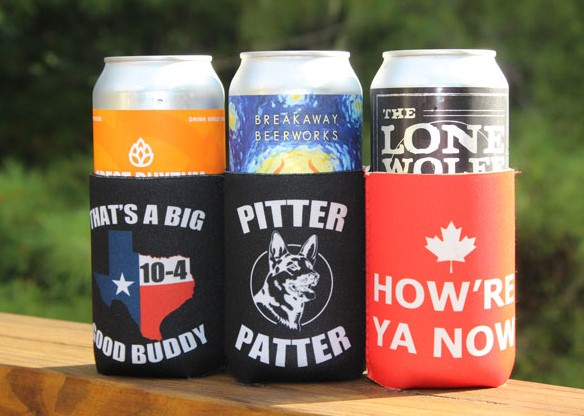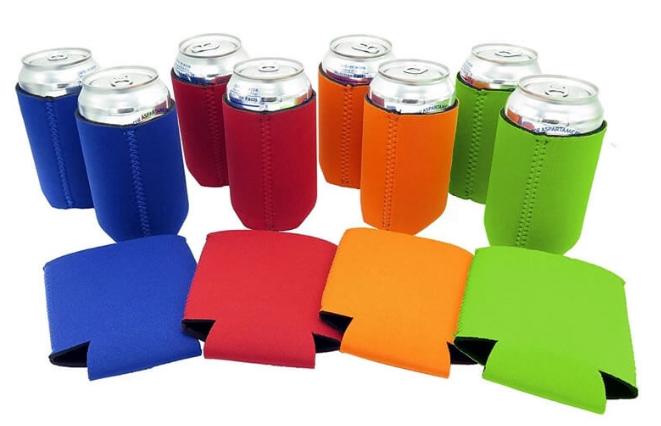If you’ve ever gone to a summer barbecue, tailgate party, or outdoor event, you’ve probably seen beer koozies. But you might be wondering ‘what does a koozie do?’ You also may not know the science behind how these simple foam sleeve and cloth (or other materials) can keep your beverage cold. These foam drink sleeves are a need for outdoor events, including picnics, family reunions, and barbecues.
Insulated containers, like koozies, use a combination of temperature control and air retention to achieve their unique chill-maintaining powers.

Not all koozies are created equal – so if you want to find the best beer koozies for bottles and cans on Amazon, check out our guide now!
With it, you’ll learn the science behind beer koozies and determine which ones give you the most bang for your buck.
What is Koozie?
A construction site worker in Texas created the Koozie brand in 1979. Old school beer Koozies are usually neoprene beverage insulators. It is similar to Kleenex or Q-Tips, two brand names that have come to be associated with different kinds of cotton swabs or tissues, respectively.
In modern slang, the term “koozie” is now frequently used to describe a variety of coolers and can and bottle beverage insulators. At its most basic level, a Koozie is an insulating sleeve that wraps around a canned or bottled beverage. A koozie is also sometimes known as a beer cozie. Many people ask “Do beer koozies work?” and the answer is yes!
The material of the Koozie is meant to keep the beverage cool while maintaining its temperature for a more extended period. The design of the Koozie includes air pockets, which are essential in heat transfer (which helps keep your beer bottle or can cold).
History Of The Koozie
The 1800s: When teapots had knitted covers to keep them warm in British history, the idea first appeared.
1921 to the present: Many people submit patent applications for numerous designs of insulated beverage sleeves. Bonnie McGough, an Idaho resident who got a patent in 1981 for a collapsible fabric cylinder containing packets of goose down or other insulating materials, was one of those inventors.
In the mid-1970s: Alex Lang, an Australian inventor, develops a gadget for keeping beer cold. Beer is typically packaged in 375-milliliter short and stubby bottles in Australia, hence the name “stubby holder.” Surfers quickly take to stubby holders.
1980: Beginning with the production of Styrofoam can coolers, Radio Cap Corporation (RCC) of San Antonio, Texas, registers a trademark for the name “Koozie.” Foam and neoprene are later updated from the original substance.
1991: RCC is acquired by Norwood Promotional Products and continues to grow the custom Koozie line.
2001: After RCC permits the “Koozie” trademark to expire, a legal dispute arises between Norwood and Kustom Koozies. Ownership ultimately belongs to Norwood.
2009: Bic Graphic buys Norwood, creating, selling, and distributing genuine Koozie products. (Totally Promotional is an authorized seller of the genuine Koozie brand name by Bic Graphic/Norwood.)
What Is A Koozie Used for?
A koozie for your canned or beer-bottled beverage is more than a style statement. This drink holder offers many benefits, including:
- It keeps your hands from being chilly
- Keeping tables free of water rings
- Insulating your beverage
- It prevents condensation on your beverage
The Science of Insulation
At its core, insulation slows heat transfer from one object to another. In the case of beer koozies, they are designed to slow down the transfer of heat from your beverage to its surrounding environment.
Most koozies are made from closed-cell foam or neoprene fabric; these materials have tiny pockets of air between them which act as an insulator against heat transfer. So when you place a can or bottle in the neoprene Koozie, it forms an extra layer between your drink and its environment, which helps keep it cool for longer.
The Cooling Effect of Condensation
In addition to providing insulation for your beverage, beer koozies also use condensation to help keep drinks cold. The process of evaporation releases energy in the form of heat. Condensation, however, helps remove some of the heat produced by condensation by absorbing energy and evaporating again.
Since beer koozies are often made with moisture-absorbing materials (like neoprene), they create more condensation on the outside surface, which helps keep beverages colder for longer!
Maintaining Your Beverage’s Temperature
So now that we understand why beer koozies work let’s talk about how to get the best results. The most important thing is to make sure that you store your beverage in an airtight container before placing it inside the Koozie; otherwise, warm air will be able to enter and decrease its temperature more quickly.
Additionally, be sure not to leave your beverage in direct sunlight as this will cause it to warm up faster than if it were stored in a shady area or indoors.
And lastly, make sure to store unused cans/bottles in their original containers with lids until ready for use; this will ensure that they stay as cold as possible!
Thermal Insulation
The concept of thermal insulation is the key to understanding how beer koozies work. Thermal insulation is any material that can reduce heat transfer between objects.
In this case, a beer koozie acts as an insulator that slows down the rate of temperature change between your beverage and its surroundings.
This process allows you to keep your drink cold for extended periods to enjoy it at its optimal temperature.
Conduction and Convection
Beer koozies also help reduce heat transfer through conduction and convection. Conduction is when heat is transferred through direct contact between two different objects (in this case, your hand and the cool can).
To reduce this heat transfer, some beer koozies have a layer of foam or neoprene on both sides so that there is less contact with the outside air and more contact with the cool liquid inside the can/bottle.
Convection is when heat is transferred by currents in liquid or gas (in this case, outside air). Beer koozies help reduce convection by trapping air in their tiny pockets or pores and slowing down the rate at which heat transfers from outside temperatures into your beverage container.
Conclusion
Beer koozies are essential for any outdoor event where cold beverages are served. They provide insulation to keep drinks colder and prevent condensation buildup on the outside containers and glasses. By understanding how they work, we can better appreciate how helpful these little accessories are.




